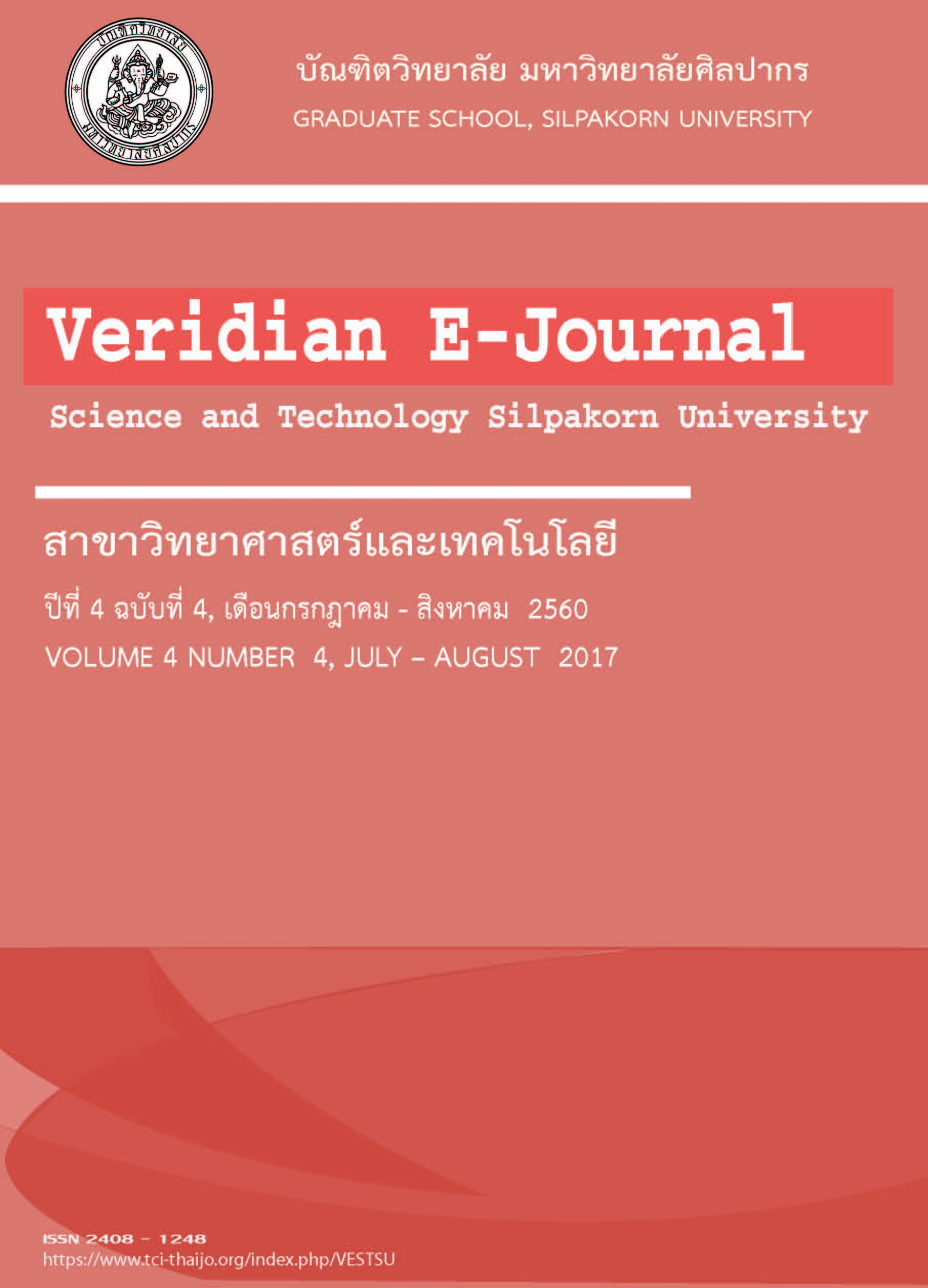การออกแบบอินโฟกราฟิกเพื่อพัฒนาความคิดสร้างสรรค์ (A Design of Infographic for Developing Creative Thinking)
Main Article Content
Abstract
การจัดการเรียนการสอนในปัจจุบันมุ่งเน้นผู้เรียนเป็นสำคัญ (child center) เพื่อที่จะพัฒนาความคิด ความรู้ความเข้าใจ และทักษะของผู้เรียนในด้านต่างๆ รวมทั้งเปิดโอกาสให้ผู้เรียนได้มีส่วนร่วมในกระบวนการคิด การแสดงความคิดเห็น และทำกิจกรรมร่วมกันในชั้นเรียน แต่ผู้สอนส่วนมากยังคงใช้วิธีจัดการเรียนการสอนรูปแบบเดิม โดยยึดผู้สอนเป็นศูนย์กลาง (teacher center) ผู้สอนจะกำหนดแนวทางการเรียนการสอน โดยไม่คำนึงถึงความต้องการของผู้เรียน ทำให้ผู้เรียนขาดการคิดวิเคราะห์ การบูรณาการทางความรู้ และการแสวงหาความรู้ด้วยตนเอง ซึ่งส่งผลกระทบต่อผู้เรียนในหลายด้าน โดยเฉพาะด้านความคิดสร้างสรรค์ เพราะผู้เรียนไม่มีโอกาสได้คิดได้ลงมือทำสิ่งใหม่ๆ ดังนั้นการนำกลยุทธ์การสอนและกิจกรรมที่เหมาะสมเข้ามาใช้ในการเรียนการสอน จะช่วยพัฒนาประสิทธิภาพการเรียนการสอน และจะส่งผลต่อการเรียนรู้ของผู้เรียนโดยตรง การนำทฤษฎีปัญญานิยม (cognitive theory) มาใช้ในการจัดเรียนการสอนจะช่วยแก้ไขปัญหาด้านความคิดสร้างสรรค์ของผู้เรียน ซึ่งเน้นการเรียนรู้ของผู้เรียนผ่านกระบวนการคิดภายในระบบสมอง สร้างความรู้ความเข้าใจด้วยตนเอง ซึ่งเกิดจากการรับรู้และสั่งสมประสบการณ์ สามารถตีความหมาย และเชื่อมโยงประสบการณ์เดิมและองค์ความรู้ใหม่เข้าด้วยกัน โดยสามารถแก้ไขปัญหา และสร้างสรรค์สิ่งใหม่ๆ อีกทั้งยังนำรูปแบบการเรียนการสอนกระบวนการคิดสร้างสรรค์ (synectics Instructional Model) มาใช้ร่วมกับการออกแบบอินโฟกราฟิก ซึ่งเป็นสื่อที่มีทั้งเนื้อหาและภาพ ผ่านกระบวนการคิด จินตนาการ และใช้ความคิดสร้างสรรค์ในการออกแบบ โดยใช้กระบวนการออกแบบ 9 ขั้นตอน (1) เลือกหัวข้อ (2) วางแผน (3) แผนที่ความคิด (4) ค้นหาข้อมูล (5) แรงบันดาลใจ (6) แปลงข้อมูลเป็นภาพ (7) สเก๊ตช์ภาพโครงร่างและหยาบ (8) ออกแบบ (9) ตรวจสอบและปรับปรุง เพื่อส่งเสริมให้ผู้เรียนเกิดความคิด ปัญญา และการรับรู้ ได้รับประสบการณ์ตรงจากการคิด ตัดสินใจ และลงมือทำ สร้างความรู้ใหม่โดยบูรณาการความรู้เดิมและใหม่เข้าด้วยกัน ซึ่งจะนำไปสู่การพัฒนาความคิดสร้างสรรค์อย่างเป็นระบบและยั่งยืน
Nowadays, the child centered approach is used for instruction widely in the world to develop thinking skill knowledge and competency of learners including the opportunity of learners in participating in thinking process, giving opinion and participate in learning activity in the classroom. In contrast, the instructors often used the traditional way; teacher centered approach, in the instruction. The instructor assigns the learning activity which is not connected to the learners’ need. The learners cannot have opportunity to use the critical thinking. The learners also cannot integrate knowledge or construct the knowledge. This problem effects to the creative thinking of learners from the lack of opportunity to create new idea or new things. So the application of instructional strategy and appropriate learning activity in the instructional system will be able to enhance the efficiency of instruction and learning achievement. The application of cognitive theory in the instruction can solve the problem of creative thinking of learners. The learning process focuses on thinking process and to construct the knowledge form prior knowledge and new experience. The knowledge is created form the perception and prior knowledge, learning experiences and the learners interpret the experience and connect with the prior knowledge and new knowledge. The knowledge can help the problem solving and create new things. In addition, the learning process with the use of synectics instructionl model and infographic with content and image through thinking process and imagination are used in infographic design. The process of design composes of 9 steps; (1) select the topic (2) planning (3) mind mapping (4) search for information (5) inspiration (6) convert information to image (7) sketch the draft (8) design (9) inspect and improve. The process of design can enhance the learners to use thinking skill, cognitive and perception from the direct experience to think, making decision, and doing. The knowledge is constructed by integrating of prior knowledge and new knowledge and at last, the creative thinking skill is developed systematically and sustainable.

